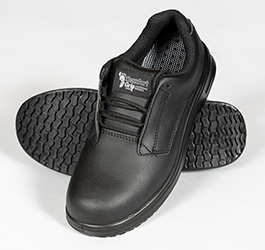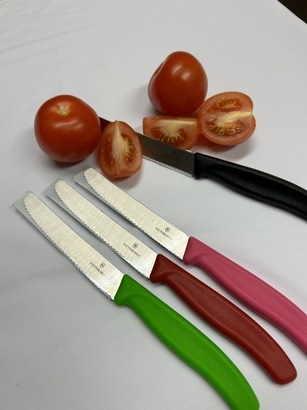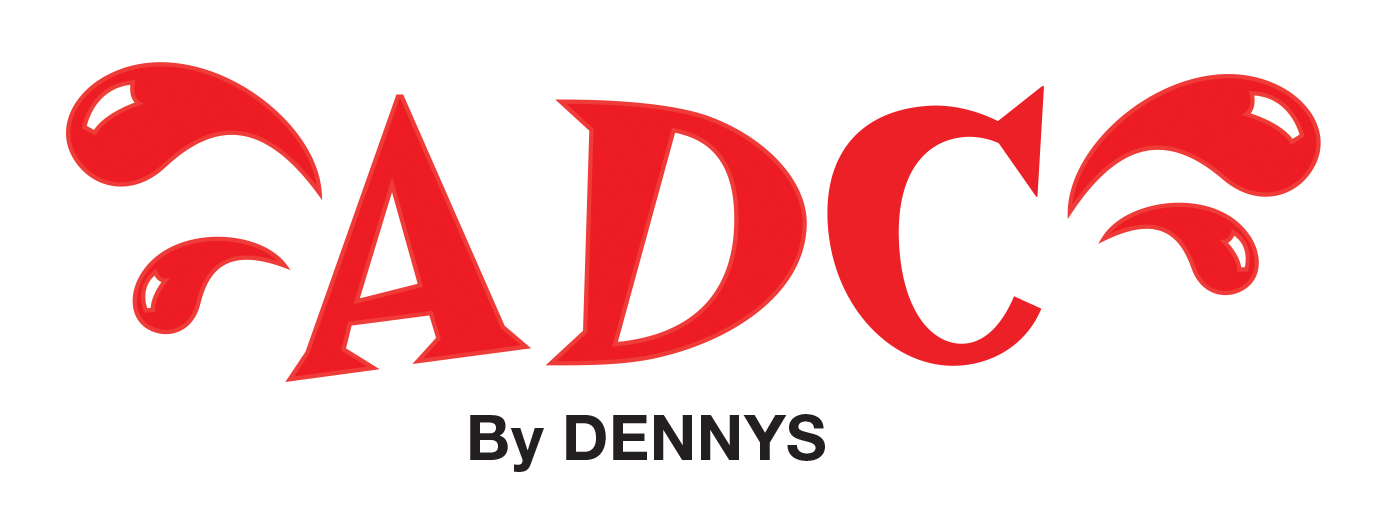Safety Shoe Ratings

There are two ratings to consider when buying kitchen shoes:
1. Anti-slip
2. Safety: a protective toecap
The anti-slip safety guideline has recently been updated.
While previously there was a SRA, SRB and SRC ratings, now there is a singular rating: SR.
An SR rated shoe has been passed a test on a ceramic tile floor that has been saturated with glycerine. Glycerine is a component found in vegetable or animal fat.
SR now covers all previously rated shoes.
SRA was tested on a ceramic tile floor that has been saturated with sodium lauryl sulphate, which is found in soap.
SRB was tested on a steel floor that has been saturated with glycerol. Glycerol is a naturally occurring alcohol that feels oily.
SRC must pass both of these tests.
This recently updated rating system: EN ISO 20345: 2022, requires the singular new SR rating as mandatory.
If you see a Ø symbol, it does not pass the SR rating. These shoes have studs or spikes, which are needed in particular workplaces, but do not meet the SR requirement.
The EN ISO 20345: 2022 guidelines also have a list of other safety additions, as following:
A: offers protection from static shocks, but not full exposure against electronics or exposure work.
AN: stands for ankle protection. This is measured by KN or N(Newton) which is a measure of force. To hold this safety rating, if the force is transferred it cannot exceed 10KN. By itself, it cannot exceed 15KN.
C: This is measured in megaohms which is the unit of resistance to electricity in an insulating item. The higher the number, the better the resistance is. To be granted this safety rating, in the shoe the electrical resistance between your foot and the ground must not exceed 0.1 Mega Ohms.
CI: CI measures cold insulation: how well protected you will be from the cold. It must pass a test conducted at 17 degrees Celsius for 30 minutes, with a temperature reduction of no more than 10 degrees Celsius.
CR: CR stands for cut-resistant. With this rating, the upper of the shoe is resistant to cuts from sharp objects.
E: Within the seat region of the shoe (the rear 10% of the shoe's total length, including the upper and sole), the energy absorption must be at least 20J. J is the energy measurement Joules which measures the capacity to generate heat or do work.
FO: This rating means the shoe is resistant to fuel oil.
HI: This rating offers insulation against hot surfaces. The test that must be passed, is conducted at 150 degrees Celsius for 30 minutes, with an increase throughout in temperature of no more than 22 degrees Celsius.
HRO: This stands for heat resistant outsole. It has been tested to be resistant to contact with hot surfaces of up to 300 degrees Celsius for 60 seconds.
LG: This rating offers ladder grip.
M: This rating gives metatarsal (the bones in your foot) protection for impacts of up to 100J (Joules, as explained above.)
P: the presence of a metal anti-perforation sole. This particular rating is tested with a 4.5mm nail to withstand at least 1100 newtons of pressure. A newton measures the amount of force required to accelerate an object, precisely the force required to accelerate an object, with a mass of 1 kilogram, 1 meter per second squared.
PL: The same as the rating above, but it also must have no separation of the layers during all tests.
PS: Has a non-metal anti-perforation sole that is tested with a 3.0mm nail. It must have an average penetration value of no lower than 1100 newtons, tested over the course of four tests.
SC: Offers protection against abrasion to the scuff cap: a piece of material at the front of the boot that is designed to protect the leather which covers the toe cap. It is tested against 1000 abrasion cycles to determine if the scuff cap can protect the toecap.
WPA: Stands for water penetration and absorption. This rating means the entire upper material of the shoe is resistant to water, and the shoe is breathable.
WR: This rating is for water-resistant footwear that offers a waterproof membrane.
- The safety ratings are as follows:
Within the EN ISO 20345 standards, there are various ratings that are used to determine what level of protection a piece of footwear provides. The most updated version (EN ISO 20345: 2022) has the following ratings:
SB: This stands for safety basic. SB is the basic safety requirement for footwear and has a protective toecap that can withstand a 200J(Joules) impact. SB-rated shoes are suitable for workplaces where toe protection is required, but there is no risk of damage from underfoot.
S1: This rating has the same protection as the SB shoe but with also has a closed heel, antistatic protection and energy absorption in the heel.
S2: This rating has the same protection and features of S1 footwear, and it also has a waterproof exterior.
S3: S3 footwear has the same protection and features of S2 footwear. It also has midsole penetration resistance, which prevents sharp objects penetrating the footwear and damaging your foot.
S4: S4 footwear has the same features as S1 footwear but instead is made from a rubber upper or entirely moulded polymer: e.g. a wellington boot material, giving S4 footwear waterproof and leak-proof properties.
S5: S5 footwear has the same features as S4 footwear, and also has midsole penetration resistance.
S6: A new rating introduced within the EN ISO 20345: 2022 standard, S6 footwear has the same features as S2 footwear, and also has water resistance for the whole piece of footwear.
S7: Also introduced within the EN ISO 20345: 2022 standard, S7 footwear has the same features as the S3 footwear, and also has water resistance for the whole piece of footwear.
When reviewing which markings a shoe has, it is worth double-checking which ISO standard it falls into. They may differ slightly depending on which year it falls within.












